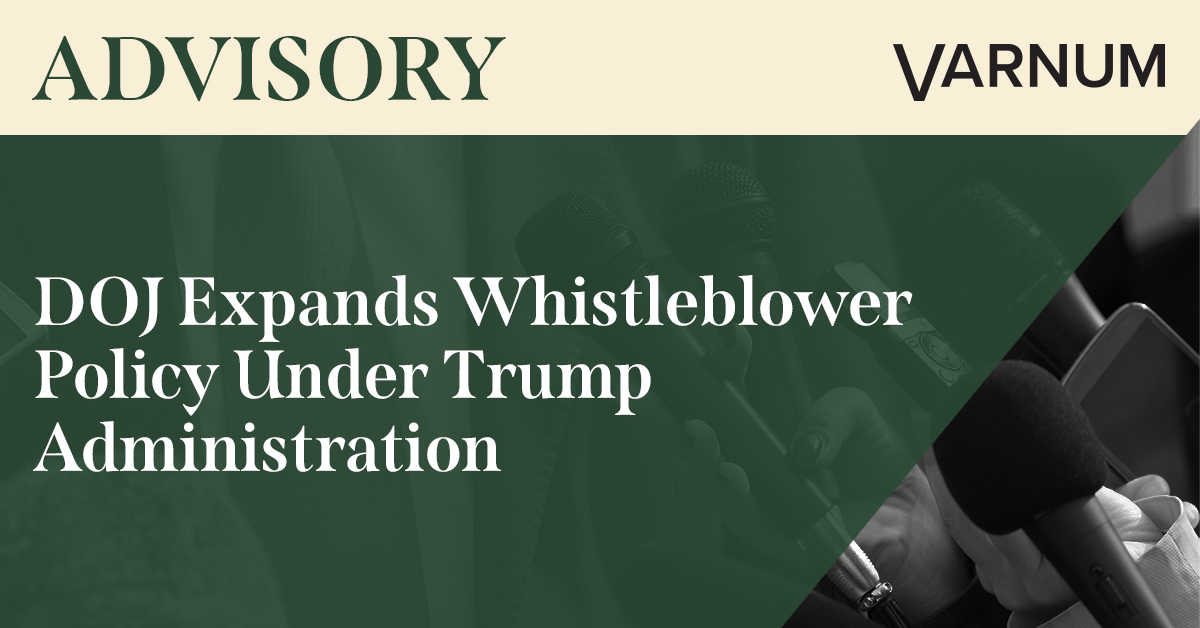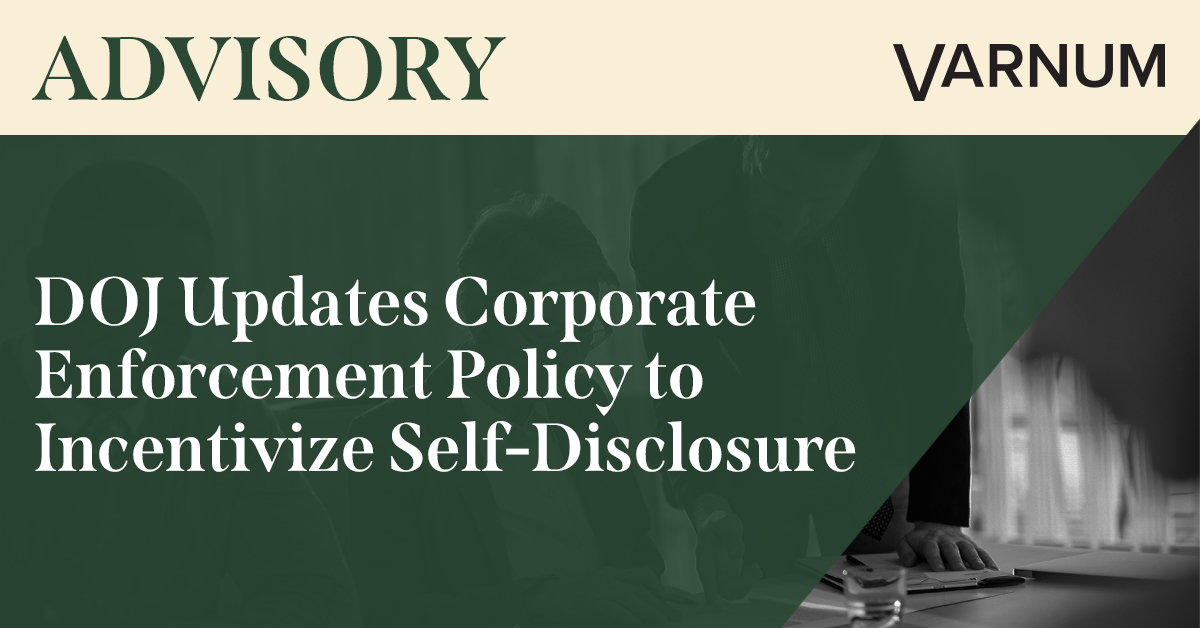Following months of uncertainty and speculation regarding the future and scope of white collar enforcement under Attorney General Pam Bondi, the United States Department of Justice Criminal Division has publicized its new policy on white collar crime.
In a memorandum dated May 12, 2025, and in a speech the same day, Criminal Division head Matthew R. Galeotti, unveiled three “core tenets” that will guide the division’s approach to white collar investigations and prosecution: focus, fairness, and efficiency. Galeotti followed up on these announcements in another speech delivered on June 10, 2025.
These core tenets are accompanied by a renewed focus on the prosecution of individuals committing crimes affecting federal benefits programs, the U.S. economy and markets, and national security, with a diminished emphasis on holding companies responsible for the actions of individual directors, officers, and employees.
Focus
Galeotti identified four broad areas of focus for the Criminal Division:
- Waste, fraud, and abuse in government programs
- Complex frauds that victimize United States investors and weaken the integrity of markets
- Crimes that exploit U.S. monetary systems
- Threats to the United States economy, competitiveness, and national security
Within these areas, Galeotti specified “high impact” offenses that the Criminal Division will prioritize, such as healthcare, program and procurement, investment, and elder fraud, and “fraud that threatens the health and safety of consumers;” bribery and money laundering (particularly that impact United States interests, threaten national security, or facilitate the activities of cartels, transnational criminal organizations, or foreign terrorist organizations); customs, trade, tariff, and sanctions violations; crimes involving foreign adversary companies listed on United States exchanges; and crimes involving digital assets that victimize investors and consumers or that facilitate other criminal conduct.
Fairness
The May 12 announcements continue the DOJ’s trend of prioritizing the prosecution of individuals over corporations. Amplifying Deputy Attorney General Sally Yates’s message in 2015, Galeotti stated, “The Department’s first priority is to prosecute individual criminals” involved in corporate crime because “[i]t is individuals—whether executives, officers, or employees of companies—who commit these crimes, often at the expense of shareholders, workers, and American investors and consumers.”
Moreover, the May 12 memorandum observes that “not all corporate misconduct warrants federal prosecution,” so “civil and administrative remedies directed at corporations, are often appropriate to address low-level corporate misconduct[.]” This emphasis on prosecuting individuals continued in Galeotti’s June 10 remarks, when he observed that recently published guidelines for DOJ investigations and enforcement of the Foreign Corrupt Practices Act reflected “common sense principles, such as focusing on specific misconduct of individuals, rather than collective knowledge theories.”
Accompanying this focus on individual liability is a revised Corporate Enforcement Policy that provides a “clear pathway” to criminal declination for proactive, cooperative companies. If declination is not appropriate, corporate resolutions should last no longer than three years except in “exceedingly rare cases.” The Criminal Division also plans to review existing agreements for early termination and will consider the duration of the post-resolution period, a substantial reduction in the company’s risk profile, the extent of remediation, the maturity of the corporate compliance program, and whether the company self-reported the misconduct. Going forward, prosecutors must regularly assess resolution agreements to determine whether early termination is appropriate.
Efficiency
Recognizing that white collar investigation and prosecution are important, but can be costly and intrusive to businesses, the division announced new instructions for the conduct of corporate investigations. First, prosecutors must take all reasonable measures to minimize the length and collateral impact of investigations and make charging decisions as swiftly as possible. Galeotti’s office will track investigations to ensure they do not linger, and he reiterated in his June 10 remarks that the Criminal Division will move investigations “expeditiously” and “do its part to charge or decline quickly.” Second, as discussed more fully in a separate memorandum, the Criminal Division will limit the use and scope of monitors, with a new emphasis on narrowly tailored mandates and minimizing expense, burden, and interference with the business.
Analysis
Galeotti’s recent speeches and May 12 memorandum suggest the reports of the death of federal white collar criminal enforcement might have been exaggerated. The new policies reflect this administration’s keen interest in using “white collar” tools to pursue drug cartels, transnational criminal organizations, foreign terrorists, and foreign trade-related offenses, but many of the areas of focus in white collar prosecution are not new. In his June 10 speech, Galeotti emphasized that the DOJ remains committed to “an aggressive and robust strategy to investigate and prosecute white-collar and corporate crime.”
Considering ongoing attrition at the DOJ and high-profile dismissals and clemency in corporate, fraud, crypto, and public corruption cases, how the DOJ will deploy resources toward traditional white collar crime is an open question. For example, the Criminal Division plans to devote resources to prosecuting “trade and customs fraudsters” who circumvent the “rules and regulations that protect American consumers.” Yet this initiative seems at odds with Executive Order 14294 issued on May 9, 2025, which states the policy of the United States is to disfavor criminal enforcement of federal regulations.
Galeotti’s disdain for “lengthy and sprawling investigations” in his June 10 remarks, and emphasis on efficiency and sensitivity to the costs of investigations suggest that targets of investigations might have a receptive audience with DOJ supervisors if investigations linger or spiral in scope. But the decision whether and when to appeal to supervisors must be carefully considered. Galeotti urged targets and their counsel to exhaust discussions with line prosecutors to narrow disputed issues and advised them to be “conscientious about what, when, and how you appeal the decisions of Trial Attorneys and AUSAs.” Galeotti specifically warned that prematurely seeking relief, “mischaracterizing prosecutorial conduct, or otherwise failing to be an honest broker” will be “counter-productive to your appeals” and might undermine otherwise meritorious arguments.
The new white collar policy should be considered in context with the revised corporate enforcement policy, the whistleblower program, and the Pilot Program on Voluntary Self-Disclosures (VSD) for Individuals that rolled out in April 2024, which rewards certain eligible insiders with non-prosecution agreements in exchange for self-disclosure. It remains to be seen how the Criminal Division’s emphasis on individual responsibility will affect its implementation of its whistleblower and individual VSD programs.
Individuals, organizations, and counsel should keep in mind that these policies govern the DOJ Criminal Division only. They do not bind the 93 U.S. Attorneys’ Offices, the other litigating components at the DOJ (such as the Civil, Antitrust, Environment and Natural Resources, and National Security Divisions), other federal agencies (such as the Securities and Exchange Commission), or state and local authorities. These policies might have significant persuasive weight in how U.S. Attorneys, other DOJ components, and other agencies approach white collar and corporate enforcement, but it is important to consider any multi-jurisdictional aspects at play.
For help navigating the DOJ’s new white collar crime enforcement policy or revised corporate enforcement policy, contact a member of Varnum’s White Collar Defense and Government Investigations practice team.
2025 summer associate Rachel Dodds contributed to this advisory. Rachel is currently a student at Wayne State University Law School.







